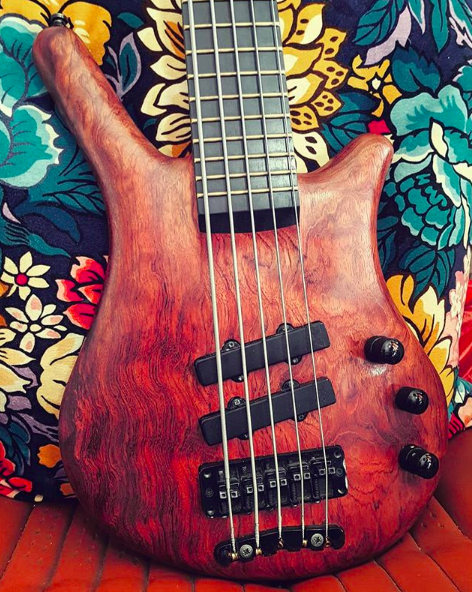
Recently I was doing the rounds, looking through the websites of various guitar companies to do a bit of daydreaming/window shopping and to see if there’s anything new that I’ve missed (hey, there’s no shame in it). I noticed a stunning new model on the Jackson site – a sparkly blue series-production version of the rare 27-fret Soloist, previously a Custom Shop model which they’re trying out as their first ever production model with more than 24 frets. This is good news.
I suppose I’m giving away my roots as a metal/shred enthusiast by professing my love for guitars with more than 24 frets, but humour me – while many people can’t see a single viable use for such a thing, this is My Blog and I can. The extra frets can be great for soloing (even if you might need to bung your fretting hand in a pencil sharpener to hit them with any precision) but what’s even better is having the extra deep cutaway to reach the 19th to 24th frets easier than on a normal 24-fret guitar. Being able to precisely place tapped harmonics is fun too.
Let me show you something ridiculous, which I used to own:

This is my old Ibanez RG550XH, a limited-run model which was available in black and a couple of different sparkly finishes a few years ago. I had an absolute blast with this guitar, I still think back to it every now and then and wonder if I should look for another one – I sold it to pay for the James Tyler, so it needed to happen, but I do have a craving for some 30-fret action in my life again. It was dirt cheap, and played great. I pretty much used the bridge pickup exclusively, it had an active neck pickup ‘simulation’ which I never really bothered with if I’m honest. Reactions-wise, it received a mixture of amazement, amusement and, perhaps most frequently, bemusement. If I got another one, I’d try to hunt down a blue example and probably give it a mirror scratchplate with just a single humbucker.
Rock and f’n roll.
Other guitars are available though, so let’s have a look at some of the stuff you can get hold of if the thought of having your range extended upwards is getting you excited.

If you’re prepared to splash the cash, there are any number of 27-fret Caparison models out there, the bolt-on neck Horus being perhaps the best known, the very high-end thru-neck TAT being the poshest, and there have been a few signature artist models with 27 frets as well. But the one I’m going to share, which I covet the most, is the now-discontinued Apple Horn Jazz, the fixed-bridge variant of Swedish madman Mattias Eklundh’s signature guitar. This, and one of Caparison’s Brocken baritones, would be a formidable pairing for recording some metal guitars…

Way back in the late 80s, the era of excess which I rather wish I’d been there for, Washburn were making a whole line of guitars with crazily extended fretboards, the excellent Stephen’s Extended Cutaway (still used on Nuno Bettencourt’s N4s) being the unique selling point. There was the rare bolt-on EC26 – name corresponding to the number of frets – but even cooler is the thru-neck EC29. Or, if that just isn’t excessive enough for you, why not delete the neck pickup (because there simply isn’t space) and have a full three octaves? The EC36 is truly ridiculous. You might see it as a shark-jump moment for the 80s superstrat craze, I prefer to view it as a glorious folly for true connoisseurs.

Hamer more than dabbled in extra frets in the 80s too. The relatively plentiful, bolt-on Californian superstrat design boasted a healthy 27 frets, but cooler still was the very, very limited-run, hand-made Virtuoso model, a delightfully well-resolved double-cutaway, set-neck shape with, again, a dog-bothering 36 frets. A few years ago, the *ahem* colourful character that was the late Ed Roman offered a recreation of the Virtuoso model through his custom shop, although how many of those exist is unclear. I gather that ‘real’ Virtuoso models (Virtuosi?) are very rare too. Perhaps even in the 1980s, there wasn’t THAT much call for 36 frets. Many of them had Floyd Rose bridges, although some appear to exist with fixed bridges – including this phenomenally tasty-looking apple green example on the right. I always love a nice shiny green guitar, especially when it gives you enough range to transcend human hearing altogether…

Did you know PRS made a few 27-fret guitars in the early days? The hand-made Sorcerer’s Apprentice dates from the pre-factory era and there are, as far as I know, only a handful in existence. It was based on the equal-cutaway shape, a la the Santana model, and appeared to have three P-90s, the back two of which are jammed together to, presumably, give a humbucker sound. There was even a 12-string example, a glorious symbol of excess if ever there was one. I’d love to see this model brought back – I doubt it’ll happen, but a man can dream.

Logic dictates I should save the most excessive til last – I thought we’d have a job finding something crazier than the Washburn or the Hamer, but then a long-buried memory resurfaced… allow me to introduce the Gary Kramer Turbulence. This delta wing-shaped weapon was available, of course, with 29 frets (for the weak-willed and prudish among us), or with a full complement of 36 frets – either with a fixed bridge or a Floyd Rose. And seven strings, if you wanted. If it’s worth doing, it’s worth overdoing.
Don’t try and tell me these don’t ROCK.





